As a parent, shopping for hockey gear for young children can be a daunting task. You may wonder which pieces of equipment are essential for your child to participate in the sport and how much each piece will cost. And then there’s the question of whether you should get name-brand or generic hockey equipment?
Unfortunately, parents can easily become overwhelmed by all the choices when it comes to buying hockey gear for a young player. This article will explain the various pieces of hockey equipment and discuss what equipment do you need to play hockey?
*The product links in this post are affiliate links, which means that if you purchase after following one, I make a small commission from the sale at no additional cost to yourself. Please see our disclosure page for more information.
You may also like
- At what age should kids start hockey?
- 15 physical benefits of playing hockey
- Top 8 | Best Hockey Wax With Helpful Guide
Hockey Gear List for Youth Players
Hockey Skates

The most important piece of hockey equipment, and probably the most expensive. Skates are made in a variety of sizes, from toddlers to adults. You can buy skates at many places, but I recommend going to your local hockey store because you will be able to get the perfect fit for your child’s feet.
Selecting the correct size skate is critical since it has a huge impact on how well your child plays. For example, if the skate is too big, they will have trouble maneuvering on the ice and won’t push off right, which means they won’t develop their skating skills very fast. On the other hand, the opposite problem can occur if your child’s skate is too small (clumsy feet and legs).
You should also consider getting the right laces for your skates, it can make a difference in comfort and performance.
The best skates are stiff leather or plastic, which holds the foot securely in place when skating on ice. The sole of the boot should be flat so that it improves balance (this is a must) and grip when pushing off while skating. Professional players wear skates with blades that have rounded edges instead of straight sharp edges; this makes gliding easier, providing better control over direction and speed.
Hockey Pants
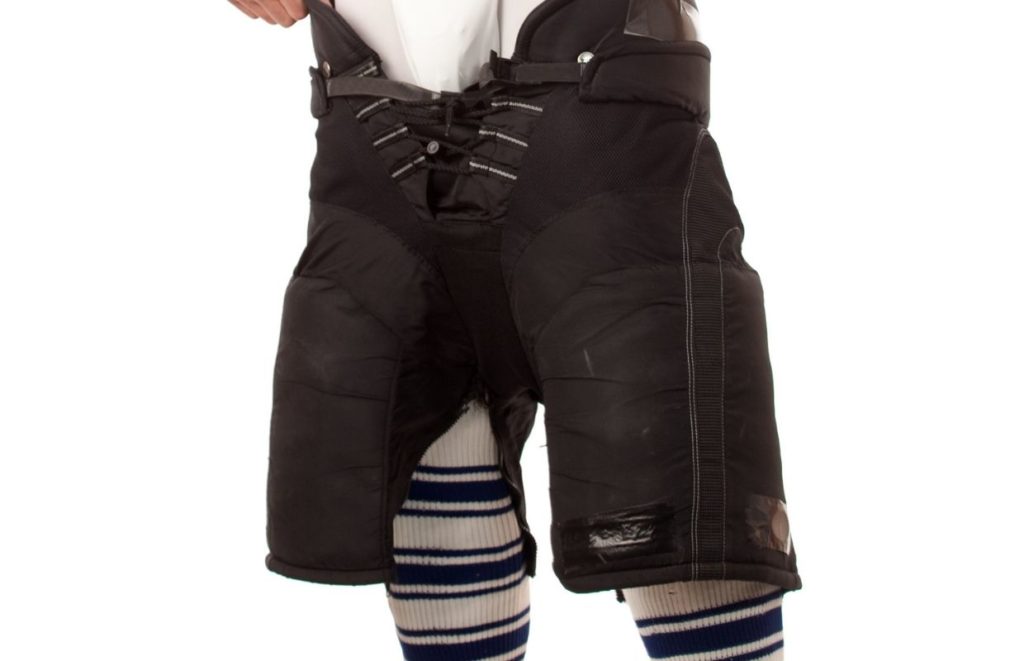
The purpose of hockey pants is to cover and protect the thighs and groin area. In addition, youth players usually wear shin or thigh pads underneath their hockey pants, designed to cushion blows from other players.
Buy a pair with vents in the back that provide air circulation; this makes them lighter and more comfortable when worn during play. Since youth hockey games last for an hour, you want your child’s equipment to be as lightweight as possible so they don’t get tired quickly while playing.
Pants are available in sizes ranging from toddlers to adults, so it shouldn’t be hard to find one that fits well. The key is finding a pair that covers your child from the knees to just below the waist. Youth hockey pants come in solid colors, but you can also find them with stripes or logos on them.
Hockey Gloves

Most players use hockey gloves because of how they help improve their grip and comfort while playing. You can buy a pair made of leather or another material (some synthetic materials dry faster than leather).
Whether you select a left-hand or right-hand glove, the fit should be an issue when buying gloves for your child since youth sizes are not available easily. Also, make sure that there is enough room at the end of each finger so they have full control over their stick and puck.
Some elite players don’t choose to use hockey gloves because they want to improve their stick handling skills by using bare hands. But you’ll probably find that hockey gloves are too valuable in terms of improving a young player’s performance, so it makes sense for your child to use them.
Hockey Stick

Of course, a hockey stick is an important piece of equipment, getting the right one will help players move the puck and shoot the puck into the goal. Sticks come in different weights, sizes, and materials (wood, aluminum, or graphite). In addition, hockey sticks have curved blades, which allow them to glide more easily over the ice.
The most common type of blade is the toe curve which curves down slightly at a player’s toes and up toward his heel; this makes shooting easier since a player can easily direct pucks toward the goal. Another common blade is the heel curve that curves upward toward the heel, making it easier to scoop pucks out of corners.
Hockey players can buy a new stick or rent one if they prefer not to spend too much money on equipment at first. Make sure your child’s stick fits their height and weight well; this improves control over the hockey puck when playing.
Hockey Helmet

A helmet is a must when playing hockey, and if your child wears one, they will look like an NHL player and protect their head from all kinds of injuries. If your child’s helmet fits well and doesn’t obstruct his vision while wearing it, then you’ve found the right one.
Make sure the helmet covers most of your child’s forehead; this helps prevent injury to the top of their head if they fall back onto the ice surface. It’s also important that helmets have full-face protection, so players don’t get injured by high-impact hockey pucks.
Another feature that helps players avoid injury is a chin strap; this ensures that the helmet stays secure throughout the play. In addition, there are hockey helmets designed for all players, including women and children.
Neck Guard

A neck guard protects a player’s neck and throat. Since the part of the body that absorbs the most impact during an accident is usually your head, your child should be wearing this piece of equipment at all times.
Some players prefer a neck guard that is made from hard plastic since it doesn’t restrict breathing. However, you can find guards designed to be lightweight, so they don’t interfere with your child’s performance during a hockey game.
When choosing this piece of equipment, the most important concern is whether it fits well and stays put even if your child falls over while playing.
Mouthguard

Since the mouth is exposed during hockey, you’ll want to ensure your child’s safety by having them wear a mouthguard. The purpose of this equipment is to protect teeth and help prevent injuries such as broken or lost teeth when your kid falls over. It also acts as protection for the lips from cuts and scrapes that occur during play.
The best time to have your child use a mouth guard is during training sessions, so they become accustomed to wearing one regularly at practice and competitions.
Some players prefer clear mouthguards, but you can look for sports stores (like pro sporting goods) that sell colored ones if they don’t like using clear ones because they affect their ability to breathe normally while playing.
Shoulder Pads

Shoulder pads are used to protect the player’s shoulders, chest, and collarbones from injury. The best types of shoulder pads for hockey players help them move their arms while keeping the upper part of their body safe when making contact with other players.
This piece of equipment also helps protect your kid’s shoulders, chest, and collarbones from injury while preventing other players from getting injured when they make contact with these body parts.
Consider this piece of equipment as part of your child’s uniform since they will need it when playing competitive games.
Elbow Pads

Elbow pads are used to protect the elbows from injury. For example, when a hockey player falls while playing, they can suffer joint and bone damage if a piece of equipment doesn’t protect the elbow. Elbow pads provide this protection while keeping your children’s elbows warm during play, so they don’t feel uncomfortable because of cold weather.
Another good thing about these pieces of equipment is that they add extra strength to players’ forearms when making shots with their sticks/pucks, giving them more control over where the shot will go.
Shin Guards

Shin guards are used to protecting players’ shins from injury. These body parts can get bruised and damaged during a hockey game if they’re not protected with the right equipment.
You don’t want your child to be sidelined just because they have bruises on their shins, so you must have them wear this piece of equipment during competitive games.
There are shin guards specifically designed for all skill levels of players; you should pick one that fits well and doesn’t restrict movement while providing ample protection to the player’s shins at the same time.
When choosing shin guards, consider their durability since they will be subjected to impact after impact (since hockey is a contact sport). You should also check on how comfortable it is to wear since your kids will be wearing these pieces of equipment for a long time.
Socks

The best socks to use for playing hockey are those that provide support and cushion. In addition, hockey players need uniform sock wear that allows them to move and play freely without any restrictions while preventing injuries like ankle sprains.
Some of these socks are specially designed with a large padded area at the heel portion to protect the Achilles tendon, one of the most commonly injured areas in athletes who play this sport. In addition, choose socks made from synthetic fibers so they don’t shrink when washed over and over again after each game or training session.
Hockey Bag

There are different types of hockey bags out there, so you must get one that has plenty of storage space. It should also be durable since you will be using this bag for long periods of time and can withstand the weight of all your hockey gear.
The most important thing to remember when choosing a hockey bag is its size. You want a bag that can fit all your hockey gear and equipment inside it.
What equipment do you need to play hockey?
Essential Hockey Gear – what you must-have
Here is the list of Hockey Equipment that you must buy for your child:
- Hockey Helmet
- Hockey Stick
- Shoulder Pads
- Neck guard
- Mouthguard
- Elbow Pads
- Shin Guards
- Skates
- Hockey Helmet
- Hockey Stick
- Shoulder Pads
- Gloves
- Neck guard
- Mouthguard
- Elbow Pads
- Shin Guards
- Skates
The above-given pieces of equipment are a must-have as you should look for the safety of your kid before anything else.
Highly Recommended Gear
Here is the list of Hockey Gear that will help improve learning skills and safety:
- Socks and Rashguards
- Equipment bag
- Hockey Pants
- Jersey
- Your own pucks
- Electrical Tape
Extra Hockey Equipment needed For a Goalie
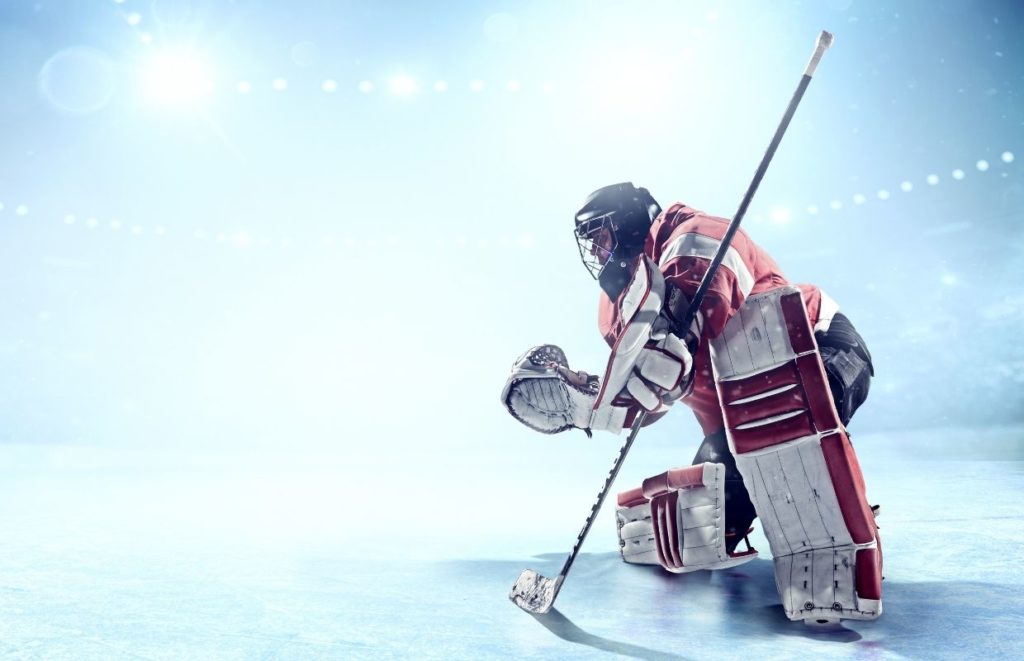
Goalies are a lot more exposed than the other players, so they must have all the safety gear to keep them safe. One thing to know is there is a difference in goalie skates when compared to regular player skates. While it’s not essential to have special goalie skates, it is recommended.
Here’s a list of other goalie specific equipment that you can get for your child:
Garter Strap
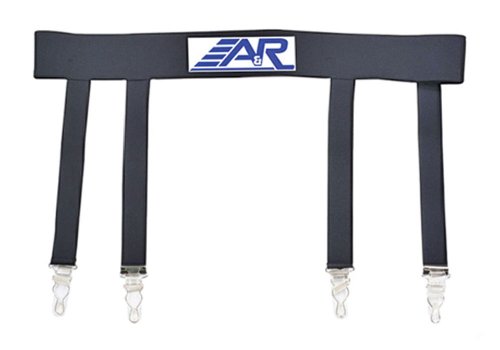
Garter Strap is used to keep the goalie’s pants on. The strap is an important piece of equipment for goalies since they’re allowed to make more body contact than field players, and their pants might likely come off at some point.
A garter strap with a Velcro attachment works best since you can easily adjust its size during gameplay. You should also get one that’s elasticized so it will fit snuggly on your child’s legs without getting loose and complicating the goalie’s movements during play.
Chest Protector
No products found.The best chest protector will have a high level of protection to protect the goalie’s ribs and sternum from being injured during gameplay. In addition, a chest protector should be rigid enough to withstand hard, powerful body shots that will be aimed at your kid for each team.
Many kids find it uncomfortable to wear a chest protector, so make sure you pick one with ample padding that makes your kid feel comfortable during play.
Goalie Stick
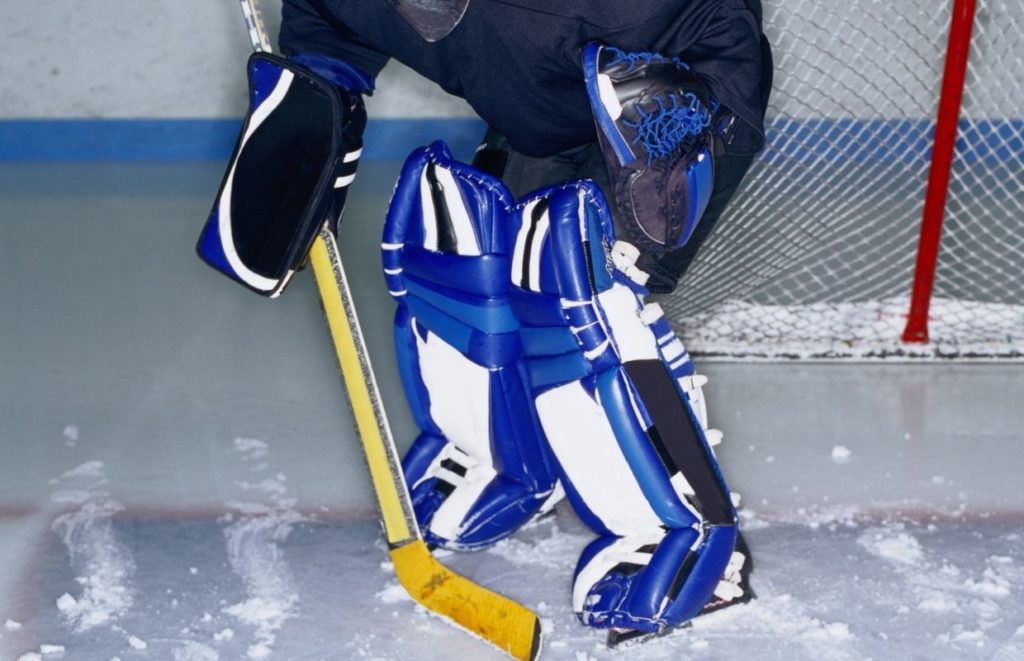
Not all goalie stick models are the same. First, you should make sure that you know the difference between a field hockey stick and one for goalies. Field hockey sticks are lightweight, have a thin blade size, and are usually made from wood or aluminum, while goalie sticks are much heavier and designed with a wider blade to deflect hard shots away from the net.
A great option for your child is an adjustable stick with interchangeable faceplates that you can change out based on what position they’re playing in at any given time.
It’s also highly recommended to get an extra stick head so you can replace your child’s current one if they get a lot of hard shots shot at it and end up breaking it.
Helmet
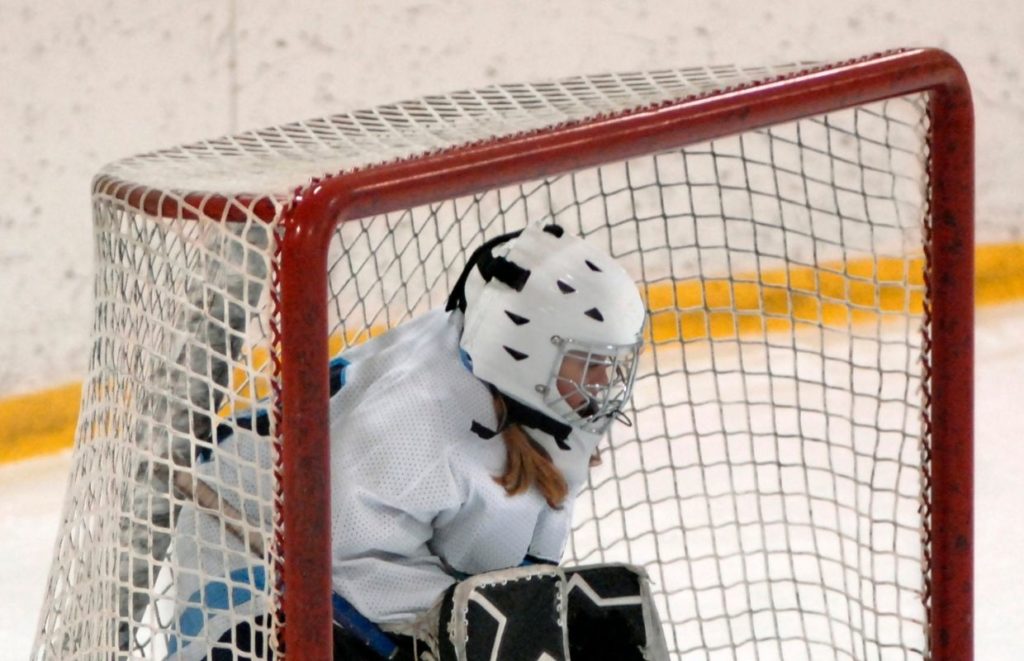
Goalies should have their own hockey helmet that will protect their head and face from hard shots. A goalie helmet has a mask attached to its front to help deflect hard shots away from the goal area.
Helmet covers are also recommended if your child’s current helmet becomes damaged or starts wearing out. Helmet covers can be worn during training sessions or games when a goaltender gets hit in the face with a hard shot and needs some extra protection to keep them safe.
Helmet Strap
No products found.Because goalie helmets are much smaller than the traditional hockey helmet that players wear, many goalies have their helmets come off during gameplay.
To fix this problem, consider getting an elasticized strap to help keep your kid’s helmet in place during play, so it doesn’t come off in the middle of the game and leave them exposed to injury.
Leg Guards

Ice hockey goalie leg guards are designed with padding and protection so they can keep your child’s knees safe during gameplay. In addition, goalies should wear leg guards to protect their legs from hard shots that get deflected off the goalie stick and make their way to the goal area.
The best leg guards have a high level of protection, but they’re still lightweight enough, so you won’t notice them weighing your kid down while they play. Look for thick foam in the front, especially around the knee and shin areas, for added cushioning and protection against hard shots.
Gloves

It would help if you got a pair of thick and heavy gloves enough to protect your kid’s hands from hard shots. Since goalies are allowed to make more body contact than field players, their gloves are often exposed to hard hits that can cause injury if the goalie doesn’t have strong protection on their hands.
Gloves should be made with leather or synthetic leather material for maximum flexibility and durability. Your child also needs to easily grip the stick while wearing gloves, so look for models with extra padding in the palm area and lightweight designs, so their movements aren’t impaired during gameplay.
Additional Protective Equipment
While all of the above focuses on hockey-specific gear, there is also a lot of other protective gear you can get that comes recommended. Examples include padded compression gear with built-in rib protectors or cups. Also, it’s one thing to own the gear, but you also need to keep it in good condition, so something to keep your skate blades sharp or protect your stick while traveling is also highly recommended.
FAQs: Hockey Equipment for Kids
How much does youth hockey gear cost?
The cost of youth hockey gear varies based on the type and quality of equipment you need. However, if your child is starting, you can expect to spend at least $100 for a stick and other basic pieces of protection. For more advanced players, you’ll likely end up spending close to $200 to purchase goalie gear and advanced equipment like shin guards and chest protectors.
Which is the best hockey gear brand?
The best brand of hockey gear depends on your child’s age and skill level. For younger players, Bauer is one of the top brands because they have high-quality youth models that are affordable and high quality. For more experienced players who want advanced gear that can withstand the rigors of intense gameplay, choose Reebok or Easton.
How often should I replace my kid’s equipment?
The frequency of replacing hockey equipment depends on how often your child plays. If they’re only going to the backyard or playing in occasional games, you can probably get away with keeping their gear for several years. If they play frequently and are prone to crashing into walls and the ground, it’s usually recommended that you replace their pads at least once a year.
What’s the difference between shin pads and shin guards?
Shin guards are made from solid material to provide a good level of protection for your child’s shins. They usually cover the entire shin, and you should get them if your child plays field hockey. Shin pads, on the other hand, have open-cell foam that provides more flexibility and breathability. Both field players and goalies can wear them because they don’t restrict movement as much as solid guards.
Conclusion
Always choose the best hockey equipment for kids by ensuring the gear meets regulation standards and is designed with their favorite position in mind.
Do let us know what gears you are planning to get your little one. Have any questions? Do let me know in the comments below.


